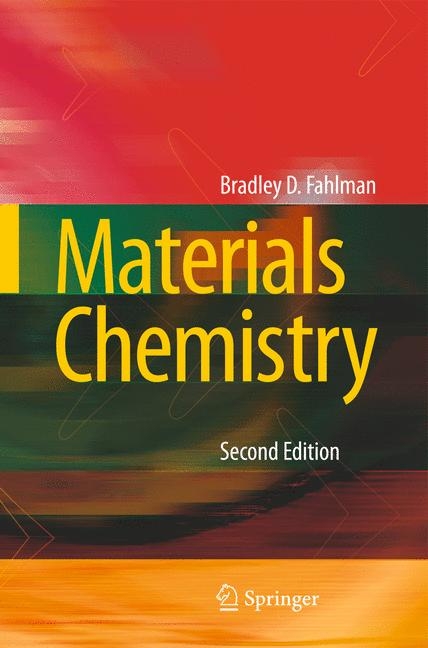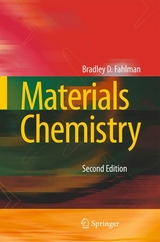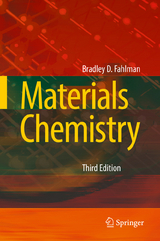Materials Chemistry
Springer (Verlag)
978-94-007-0692-7 (ISBN)
- Titel erscheint in neuer Auflage
- Artikel merken
The 2nd edition of Materials Chemistry builds on the strengths that were recognized by a 2008 Textbook Excellence Award from the Text and Academic Authors Association (TAA). Materials Chemistry addresses inorganic-, organic-, and nano-based materials from a structure vs. property treatment, providing a suitable breadth and depth coverage of the rapidly evolving materials field — in a concise format. The 2nd edition continues to offer innovative coverage and practical perspective throughout, e.g.: the opening solid-state chemistry chapter uses color illustrations of crystalline unit cells and digital photos of models to clarify their structures. This edition features more archetypical unit cells and includes fundamental principles of X-ray crystallography and band theory. In addition, an ample amorphous-solids section has been expanded to include more details regarding zeolite syntheses, as well as ceramics classifications and their biomaterial applications. The subsequent metals chapter has been re-organized for clarity, and continues to treat the full spectrum of powder metallurgical methods, complex phase behaviors of the Fe-C system and steels, and topics such as corrosion and shape-memory properties. The mining/processing of metals has also been expanded to include photographs of various processes occurring in an actual steelmaking plant. The semiconductor chapter addresses evolution and limitations/solutions of modern transistors, as well as IC fabrication and photovoltaics. Building on the fundamentals presented earlier, more details regarding the band structure of semiconductors is now included, as well as discussions of GaAs vs. Si for microelectronics applications, and surface reconstruction nomenclature. The emerging field of `soft lithographic’ patterning is now included in this chapter, and thin film deposition methodologies are also greatly expanded to now include more fundamental aspects of chemical vapor deposition (CVD) and atomic layer deposition (ALD). The polymer and `soft’ materials chapter represents the largest expansion for the 2nd edition. This chapter describes all polymeric classes including dendritic polymers, as well as important additives such as plasticizers and flame-retardants, and emerging applications such as molecular magnets and self-repairing polymers. This edition now features `click chemistry’ polymerization, silicones, conductive polymers and biomaterials applications such as biodegradable polymers, biomedical devices, drug delivery, and contact lenses. Final chapters on nanomaterials and materials-characterization techniques are also carefully surveyed, focusing on nomenclature, synthetic techniques, and applications taken from the latest scientific literature. The 2nd edition has been significantly updated to now include nanotoxicity, vapor-phase growth of 0-D nanostructures, and more details regarding synthetic techniques and mechanisms for solution-phase growth of various nanomaterials. Graphene, recognized by the 2010 Nobel Prize in Physics, is now also included in this edition. Most appropriate for Junior/Senior undergraduate students, as well as first-year graduate students in chemistry, physics, or engineering fields, Materials Chemistry may also serve as a valuable reference to industrial researchers. Each chapter concludes with a section that describes important materials applications, and an updated list of thought-provoking questions. The appendices have also been updated with additional laboratory modules for materials synthesis (e.g., porous silicon) and a comprehensive timeline of major materials developments.
Bradley Fahlman obtained his PhD at Rice University (Houston, Texas) in 2000 and was awarded his BSc. (High Hons.) at the University of Regina (Canada) in 1996. At present, he is Professor of Chemistry and Director of the Science of Advanced Materials (SAM) Ph.D. Program at Central Michigan University. His research interests involve amongst others the synthesis of novel hafnium thin-film precursors, use of these precursors for oxide/nitride/oxynitride thing film growth using chemical vapor deposition (CVD) and atomic layer deposition (ALD), development and electrochemical testing of novel nanomaterials for Li ion battery anode applications and mechanistic investigation of low-temperature carbon nanotube/nanofibre growth. Dr. Fahlman's research group is focused on the design of new and improved routes toward interesting and industrially useful nanostructural materials and thin films. More information may be found at http://www.cst.cmich.edu/users/fahlm1b/Site/Home.html. Bradley Fahlman received a 2008 Textbook Excellence Award from the Text and Academic Authors Association (TAA) for the first edition of his book Materials Chemistry.
Chapter 1.What is Materials Chemistry? Historical Perspectives; Considerations in the Design of New Materials; Design of New Materials Through a "Critical Thinking" Approach; References and Notes; Topics for Further Discussion; Further Reading .Chapter 2. Solid-State Chemistry, Amorphous vs. Crystalline Solids; Types of Bonding in Solids; Ionic Solids; Metallic Solids; Covalent Network Solids; Molecular Solids; The Crystalline State; Crystal Growth Techniques; Crystal Structures; Crystal Symmetry and Space Groups; X-ray Diffraction from Crystalline Solids; Crystal Imperfections; Bonding in Crystalline Solids; The Amorphous State; Sol-Gel Processing; Glasses; Cementitious Materials; Ceramics; Important Materials Applications I: Fuel Cells; Topics for Further Discussion; Further Reading; References and Notes. Chapter 3. Metals, Mining and Processing of Metals; Powder Metallurgy; Metallic Structures and Properties; Phase Behavior of Iron-Carbon Alloys; Hardening Mechanisms of Steels; Stainless Steels; Metal Surface Treatments for Corrosion Resistance; Magnetism; Reversible Hydrogen Storage; Important (and Controversial!) Materials Applications II: Depleted Uranium; Topics for Further Discussion; Further Reading; References and Notes. Chapter 4. Semiconductors; Properties and Types of Semiconductors; Silicon-Based Applications ; Silicon Wafer Production; Integrated Circuits; Light-Emitting Diodes: There is Life Outside of Silicon!; Thermoelectric (TE) Materials; Important Materials Applications III: Photovoltaic (Solar) Cells; Topics for Further Discussion; Further Reading; References and Notes. Chapter 5. Polyermic Materials; Polymer Classifications and Nomenclature; "Soft Materials" Applications: Structure vs. Properties; Biomaterials Applications; Molecular Magnets; Polymer Additives: Important Materials Applications IV: Self-Healing Polymers ; Topics for Further Discussion; Further Reading; References and Notes. Chapter 6. Nanomaterials, What is "Nanotechnology"?; Nanoscale Building Blocks and Applications; Zero-Dimensional Nanomaterials; One-Dimensional Nanostructures; Two-Dimensional Nanostructures: The "Graphene Frontier"; Important Materials Applications V: Nanoelectromechanical Systems (NEMS); Topics for Further Discussion; Further Reading; References and Notes. Chapter 7. Materials Characterization
Optical Microscopy; Electron Microscopy; Transmission Electron Microscopy (TEM); Scanning Electron Microscopy (SEM); Surface Characterization Techniques Based on Particle Bombardment; Photoelectron Spectroscopy (PES); Structure Determination using SEM; X-Ray Absorption Fine Structure (XAFS); Ion-Bombardment Techniques; Atom-Probe Tomography (APT); Scanning Probe Microscopy (SPM); Bulk Characterization Techniques; Important Materials Applications VI: So Which Acronym Shall I Use?; Topics for Further Discussion ; Further Reading; References and Notes. Appendix A Timeline of Materials and Technological Discoveries Appendix B "There’s Plenty of Room at the Bottom" Appendix C Materials-Related Laboratory Experiments
| Zusatzinfo | 28 Tables, black and white; XI, 736 p. |
|---|---|
| Verlagsort | Dordrecht |
| Sprache | englisch |
| Maße | 155 x 235 mm |
| Gewicht | 1286 g |
| Themenwelt | Naturwissenschaften ► Chemie ► Organische Chemie |
| Naturwissenschaften ► Physik / Astronomie ► Festkörperphysik | |
| Technik ► Maschinenbau | |
| ISBN-10 | 94-007-0692-8 / 9400706928 |
| ISBN-13 | 978-94-007-0692-7 / 9789400706927 |
| Zustand | Neuware |
| Haben Sie eine Frage zum Produkt? |
aus dem Bereich





